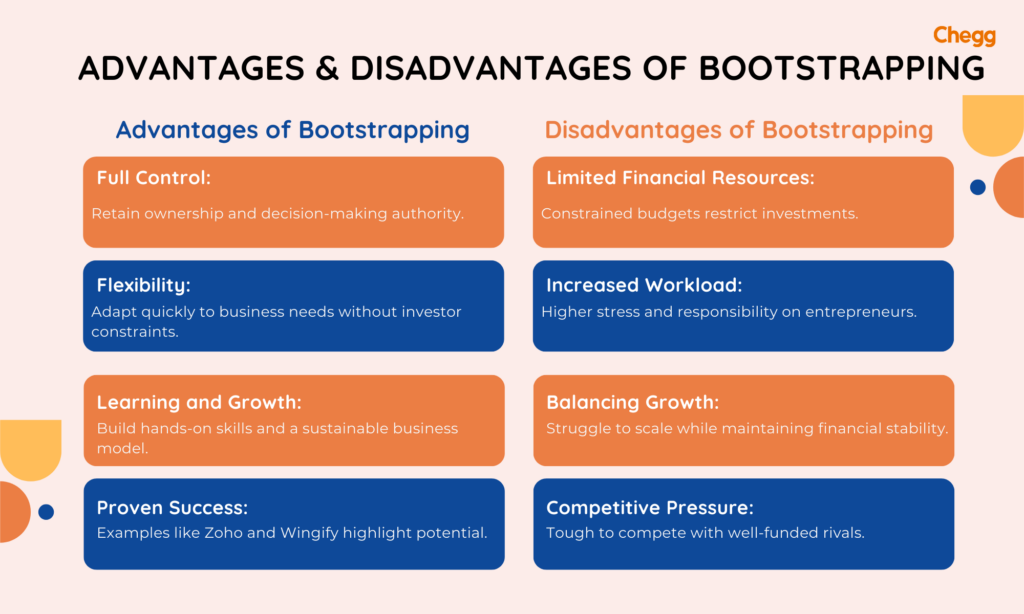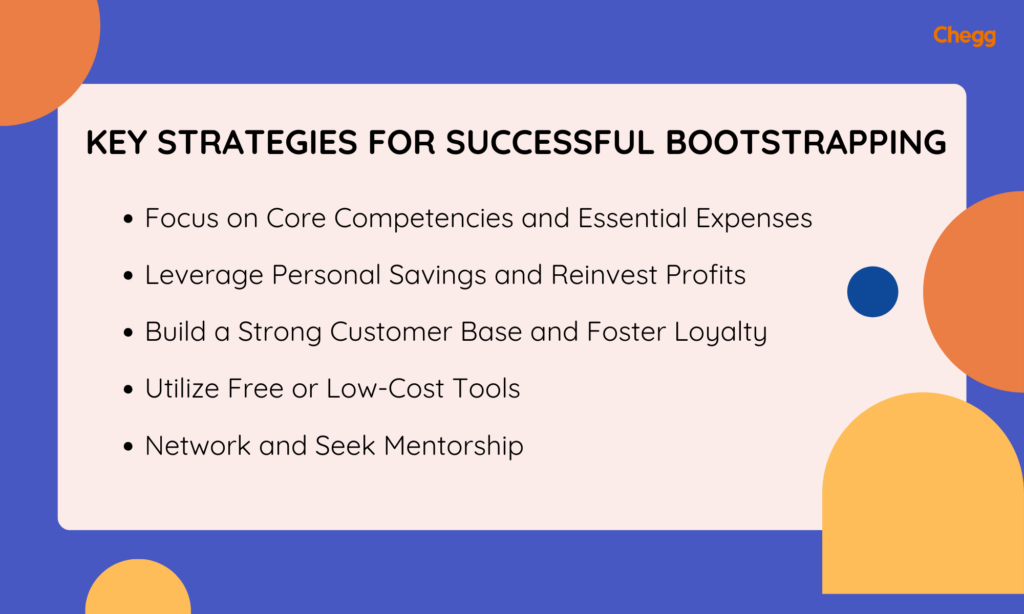

Quick Summary
Did you know that more than 100 million startups are launched every year? Yet, despite the rising number, only a fraction of them survive past their initial year. 90% of them fail to thrive in the competitive landscape of modern e-commerce. However, knowing the secret of bootstrapping might help you emerge as a winner. When you have a business idea, your first need is funding. Let us walk you through the question, ‘What is bootstrapping?’
Bootstrapping is the art of building a business from the ground up without relying on outside investors or venture capital. Despite the risks, this approach offers unparalleled freedom and control over your entrepreneurial journey. It is an exhilarating world of self-funded entrepreneurship, where the thrill of autonomy meets the challenges of resourcefulness.
Let’s get started.

Bootstrapping is a statistical method that involves resampling a dataset with replacement to estimate the properties of a statistic (e.g., mean, variance, confidence intervals) or to assess its accuracy. It involves using personal savings, revenue generated by the business, and careful resource management to fund operations and expansion rather than seeking external funding from investors or loans.
1. Focusing on Core Competencies and Prioritizing Essential Expenses
To validate a powerful bootstrapping business meaning, make sure to prioritize your expenses. You should carefully consider where and when to allocate resources. Once your business is bootstrapped, it will not have access to any external funding and should rely on internal resources to grow and succeed. For instance, if your core competence is customer acquisition, it is essential to focus on that to grow your business and generate revenue. Similarly, you have to be mindful of your expenses and prioritize product development to deliver the desired product to your customers.
2. Leveraging Personal Savings And Reinvesting Profits
Leveraging your savings and reinvesting profits will help support the expansion of your business. When it comes to bootstrapping,you might struggle to secure traditional funding from sources such as venture capital. Seeking alternative sources like crowdfunding, grants, and personal savings can provide resources to your startup without giving up equity or control of the business.
3. Building A Strong Customer Base And Fostering Loyalty
Nurturing a loyal customer base is crucial for bootstrapping in business. It will give you more than positive feedback. When your customers feel acknowledged and valued, they will promote your brand, drawing in new audiences through positive referrals. This can lower your cost of acquiring new customers and lay a strong foundation for sustainable business growth.
4. Utilising Free Or Low-Cost Marketing And Operational Tools
Take advantage of free or low-cost tools and marketing resources like open-source software, cloud-based services, and freemium products. These can help you save money on infrastructure, software, and other essential tasks. You can also hire interns to help with tasks like design and marketing, which will help cut costs on long-term employee investment.
5. Networking And Seeking Mentorship From Experienced Entrepreneurs
Networking and partnerships are essential for building relationships and collaborating with others to achieve common goals. In the context of bootstrapping, networking and seeking mentorship are valuable as they provide access to resources and expertise that you might lack. Additionally, you can network with other entrepreneurs to find potential partners and customers. This type of seamless networking can help your business gain valuable insights and potentially secure funding.
Bootstrapping and building your business without external investment might sound challenging, but the benefits are substantial. From retaining full control to learning to adapt to challenges, bootstrapping can make you a better founder. Let’s explore some advantages of bootstrapping.
Bootstrapping is an excellent non-dilutive financing method. You and your co-founders will be the sole owners of your business, allowing you to have more control over its direction. This increased control lets you concentrate on building a solid foundation and perfecting your business operations for long-term development.
Accepting investments from external sources obligates you to them. However, with bootstrapping, you focus only on your team and customers. You control your business budget, set financial goals, and build strategies without investor interference.
It is no secret that today’s landscape is growing fast. When you understand the bootstrapping meaning in business, it encourages learning and growth. This approach drives you to build a profitable business model. With positive cash flow, you can transform your startup into a multinational business.

Bootstrapping isn’t the best option for every startup. While it can offer a plethora of benefits, bootstrapping also comes with its own set of challenges. Some of the key challenges are:
Bootstrapped businesses often struggle to achieve exponential growth. They focus on building their minimum viable products or keeping their operations intact. At the same time, they don’t want to spend too much when they invest on their own. With a relatively low budget, entrepreneurs struggle to balance growth with financial stability.
Determining the most successful bootstrapping business can be subjective, varying based on criteria like revenue, impact, and industry recognition. Here are some examples of successful bootstrapped businesses:
Deals with – Online productivity tools and business software solutions.
Deals with – Conversion rate optimisation (CRO) software.

These examples illustrate how bootstrapping can enable entrepreneurs to build successful companies through innovation, strategic focus, and effective leveraging of personal resources. Each founder’s commitment to their vision and initial investment of personal funds played crucial roles in the early stages of their companies’ growth and eventual success.
Case studies of successful companies that started with bootstrapping are mentioned below.
Founder: Sara Blakely
Industry: Fashion and Apparel
Founder: Michael Arrington
Industry: Media and Technology
Founder: Nick Woodman
Industry: Consumer Electronics
Bootstrapping is a viable strategy for entrepreneurs who prefer independence and are willing to take on financial risk. It is suitable for those capable of managing resources effectively to achieve sustainable growth. You can reap the rewards if you are willing to put in the hustle. However, it doesn’t mean there aren’t any downsides. You need to understand the trade-offs and decide which route is right to get you where you want to go.
However, to practice bootstrapping in business, discipline, resilience, and a strategic approach are required to navigate challenges while capitalizing on opportunities for long-term success. Despite the challenges, bootstrapping is a rewarding approach to starting your dream business.
Be prepared to put in the hard work, always have a strategy in place, and you can become a successful founder!
Bootstrapping is the art of building a business from the ground up without relying on outside investors or venture capital. Despite the risks, this approach offers unparalleled freedom and control over your entrepreneurial journey.
Bootstrapping in data analysis is a resampling technique where multiple samples are drawn with replacement from a dataset to estimate statistics, assess variability, and improve confidence in results without needing additional data.
Bootstrapping is a resampling technique where multiple samples are drawn with replacement from a dataset to estimate statistics, assess variability, and improve confidence in results without needing additional data.
In compiler design, bootstrapping refers to the process of writing a compiler in the same programming language that it is intended to compile. It’s a clever and efficient technique where a basic or partial version of the compiler (usually written in another language) is used to build a more advanced version of the compiler in its own language.
Bootstrapping is also known as the “resampling method” or “self-sampling”. It involves repeatedly drawing samples with replacement from a dataset to estimate statistics like means, variances, and confidence intervals without assuming a specific data distribution.

Authored by, Amay Mathur | Senior Editor




Amay Mathur is a business news reporter at Chegg.com. He previously worked for PCMag, Business Insider, The Messenger, and ZDNET as a reporter and copyeditor. His areas of coverage encompass tech, business, strategy, finance, and even space. He is a Columbia University graduate.
Editor's Recommendations
Chegg India does not ask for money to offer any opportunity with the company. We request you to be vigilant before sharing your personal and financial information with any third party. Beware of fraudulent activities claiming affiliation with our company and promising monetary rewards or benefits. Chegg India shall not be responsible for any losses resulting from such activities.
Chegg India does not ask for money to offer any opportunity with the company. We request you to be vigilant before sharing your personal and financial information with any third party. Beware of fraudulent activities claiming affiliation with our company and promising monetary rewards or benefits. Chegg India shall not be responsible for any losses resulting from such activities.